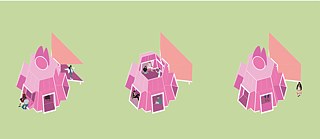Libraries between tradition and progress
Preserve and move forward

Libraries have always offered their users a share in cultural memory and knowledge of the times. This has not been changed by digitization. But the manner of knowledge transfer has.
Because they always mirrored the societies they served, the appearance of libraries has changed significantly throughout their history. But whether through the opulence of historical reading rooms or in the functional architecture of the Federal Republic’s city libraries, the focus was always on the medium of the book and the cultural technique of reading. It was the task of the library’s professional staff to select certain information for the library’s holdings and pass it on to the users. But now the Internet is making the library’s role as the “gateway to knowledge of the world” more and more obsolete.
Guides in the digital sea of data
Rather than being a “rental station”, the library is in demand as a guide. It navigates its users through a digital world in which algorithms act as lock tenders of our experience of the world. Transparency, participation and digital self-determination are therefore anything but automatisms; quite the contrary. For example, it has been argued by Nico Koenig of the grassroots project P2PU (Peer to Peer University), which focuses on new forms of knowledge transfer, that there is growing evidence that digital inequality not only reproduces but also reinforces social inequality. "If you have the motivation, support, access and digital literacy, digitization has in fact put a whole library at your fingertips,” says Koenig. “But if you don’t have those skills or support, you won’t benefit from digitization. In some cases, knowledge removes itself even further away from you.” This is exactly where the libraries come in – as mediators of the skills needed to stay on top of the daily masses of data.For Jane Kunze, who takes care of data literacy in Aarhus, Denmark, data and their selection, storage and distribution have always been the core business of libraries. Today, in digital terms, another aspect is important: to understand how information is generated and disseminated, and what sources and motives are behind these processes. This is an essential prerequisite for social and professional opportunities of participation – “whether to discover new business chances, to do better at school, raise awareness of a local problem and so on”.
Knowledge transfer in different ways
Hardly a library takes changing technological realities and social expectations more into account than Kunze's workplace, the Dokk1 in the Danish port city of Aarhus. Opened in 2015, it quickly became an international pioneer for a new self-image of libraries. The largest public library in Scandinavia, it is much more than that because it can also be used as a combination cultural, civic and knowledge centre. And its futuristic-functionalist design of concrete, glass and wood represents a radical break with more than only traditional aesthetic conventions.One of the library’s central goals is to empower young and old in dealing with a constantly changing media landscape. For example, Kunze develops learning formats that allow people to analyse and design data and to tell stories with it. In the daily media consumption of many people, data goes into a “black box”, says Kunze, and “comes out again as ‘information’ - as a newsfeed on Facebook, as a Google search result or as a data visualization.” The task of libraries, she says, is to open this black box. At the end of this process, people should be able to understand how algorithms and artificial intelligence can generate information.
At Dokk1 analogue books are therefore only one offer among many. Thus under the roof of the building located directly on the harbour docks, there is plenty of space for encounters, games and events of all kinds. Practical skills can be learned in “makerspaces”, spaces for creative work, which are now also available in many German libraries. From craftsmanship to high-tech, here joint projects are crafted and tried out, thus strengthening the know-how that is becoming more and more important in a rapidly digitized working and living environment.
The social function of learning
The focus on collaborative teaching and learning in libraries can best be explained, according to P2PU’s Nico Koenig, in that “learning is ideally a social activity". After all, we acquire large parts of our knowledge in social situations or for application in such situations. It is therefore more important than ever to understand the library as a place where “social relationships can be built”.Dokk1 is regarded internationally as a pioneer and role model, but has also attracted criticism. Critics have levelled the charge of “eventing”. And bruited the worry that, with all these changes, something has been lost. But openness to new things and awareness of traditional values need not exclude each other. "Of course”, Jane Kunze admits, “the needs of citizens are very different”. Not everyone has to become a “data analyst”. “But it’s always been the way of the public library to enable free, democratic and equal access, not to force people into things."
Dokk1 is not suitable as a template for the redesign of libraries if only because it is tailored to the specific needs of its current users. Users were engaged in concept development right from the beginning and were able to incorporate their ideas, expectations and expertise into the planning. This process makes Dokk1 again a perfect example of a contemporary self-understanding of libraries that places people and not the medium at the centre of all that libraries do.